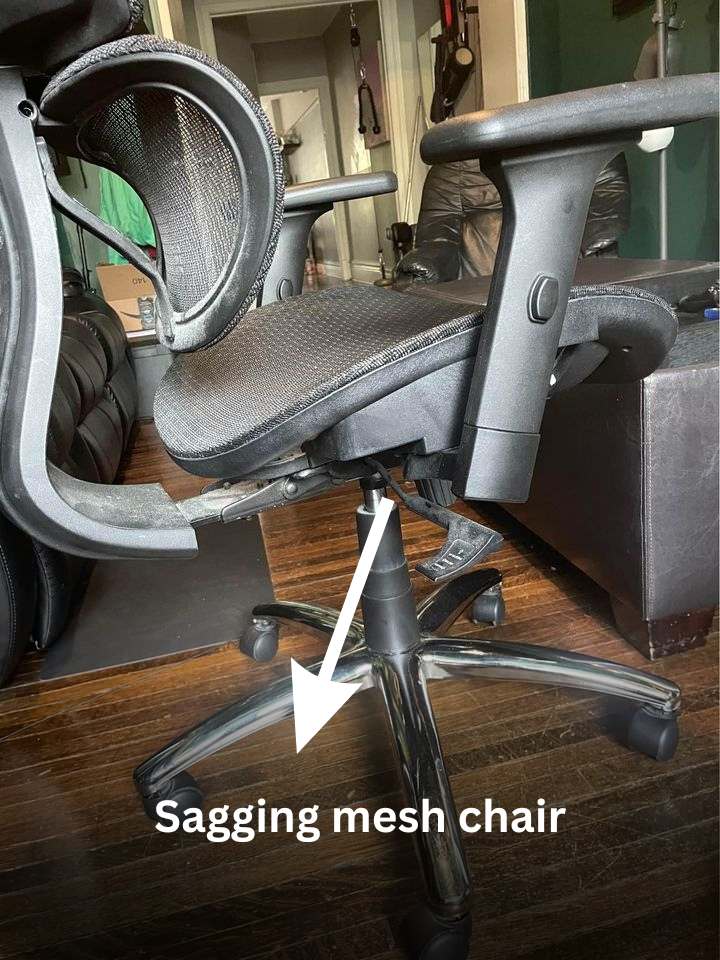
Sagging is the top complaint about otherwise comfort-focused mesh office chairs. Over 5 years, up to 70% of mesh chair owners report noticeable seat sagging that compromises ergonomic support. But with proper maintenance and care, mesh chairs can avoid a drooping demise and provide lasting, customizable comfort. Today, In this post I will reveals the reasons mesh chairs sag, preventative steps you can take, and how to restore tautness if slackness sets in.
Why Do Mesh Office Chairs Sag Over Time?
While mesh office chairs are built to be durable, the mesh material can lose tension and start to stretch and sag over years of use.

Factors That Contribute to Sagging
- Excessive weight – The mesh can only support so much before losing elasticity.
- Poor maintenance – Neglecting care weakens the mesh over time.
- Wear and tear – Everyday use slowly degrades the material.
- Tips to prevent sagging – Proper care and not exceeding weight limits preserves longevity.
Maintenance Tips for Mesh Office Chairs
With regular maintenance and care, you can prevent or minimize sagging and maximize the lifespan of your mesh chair.
Cleaning Your Mesh Chair

Regular cleaning keeps your mesh chair hygienic and helps remove abrasive dust and dirt that can degrade the mesh over time. Prioritize vacuuming weekly and spot treat stains. Diluted isopropyl alcohol can disinfect mesh safely. For tough odors allow to air out in sunlight, then sprinkle baking soda before vacuuming
Adjusting Tension and Tilt

The tension and tilt controls on your mesh chair should be adjusted periodically to maximize comfort and support. Tighten or loosen tension knobs under the seat incrementally until the mesh has minimal give when pressed but isn’t overly rigid. Lubricate tilt mechanisms, then rock back and forth checking smoothness. Adjust tilt tension and limit controls so you can rock comfortably without tipping over backwards. Refer to your chair’s user manual for help locating specific adjustment points.
Lubricating Moving Parts

Regular lubrication keeps your chair’s moving components gliding smoothly. Every 3-6 months lubricate casters, lift pistons, tilt limiter joints, adjustable arm rests and back locks using a silicone-based lubricant spray. Avoid grease or oils that can attract dirt. For gas cylinders, point straw into the drilled holes on the top of the cylinder’s interior shaft while depressing to fill. Moving parts should operate quietly and freely when adequately lubricated.
Regular Inspections and Maintenance
Inspecting your mesh chair monthly helps spot issues while still minor and ensures all hardware remains tightened. Check casters for cracks and debris, arm rests and back locks for looseness, and frame welds for rust or cracks. Confirm seat height adjustment is still smooth. Tighten any loose bolts or screws using care not to overtighten. Replace hydraulic gas cylinders every 2-3 years when lifting action becomes stiff. Proactive inspections save costs compared to waiting for catastrophic failures.
How to Care for the Mesh Material
The woven mesh requires special care to stay elastic and supportive.
Cleaning the Mesh Upholstery
Spot clean stains with a mild detergent diluted in warm water applied with a soft brush. Use light circular motions focused only on soiled areas. Rinse thoroughly with clean water to eliminate detergent residue. Allow mesh to air dry fully before using to prevent mold growth. Check care tags for any special instructions. Avoid soaking, harsh chemicals or rough scrubbing that could damage the mesh.
Additional Tips for Mesh Chair Maintenance
- Limit sun exposure to prevent fading.
- Avoid picking/pulling at snags in the mesh.
- Keep away from sharp objects that could snag or cut the fabric.
How To Fix a Sagging Mesh Office Chair
If your mesh chair has already begun noticeably sagging, don’t worry – in many cases the chair can be repaired and the mesh tightness restored without needing to purchase a whole new chair. Here are tips for fixing a mesh chair that is losing support:
Tightening the Mesh Fabric

Inspect for buttons or tension adjustment knobs located under the front edge of the seat or inside the armrests. Turn these incrementally to take up slack in the mesh and create tighter tension. Be careful not to over-tighten as this can damage the material. Test adjustments by pressing down on the mesh before sitting to check tautness.
Replacing the Mesh Upholstery
If the mesh has become too loose and stretched out to be tightened sufficiently, replacement of the mesh upholstery may be required. Some chairs allow you to swap just the separate seat mesh panel, while others require replacing both backrest and seat as a set. Installation can be tricky but is doable with time and care. New mesh should restore the chair to like-new tautness and support.
Reinforcing the Frame Structure
In some cases, the underlying chair frame can become bent or damaged, leading to secondary loosening even with new mesh fitted. Adding metal cross braces or brackets to reinforce weak structural points in the frame can help the chair’s form. Inspect plastic seat pans for any cracks as well which would require replacement.
Ongoing Preventative Maintenance
To maximize the longevity of a repaired or newly re-upholstered mesh chair, continue diligent maintenance practices:
- Regularly adjust tension and lubricate parts
- Limit sun and heat exposure
- Clean gently and frequently
- Inspect for wear and creaking
- Handle mesh carefully when using chair
- Keep to weight limits and sit upright
With proper assembly, care, and maintenance, a quality mesh task chair should provide many years of comfortable support. But if sagging does occur, the tips and repair methods provided can often get your chair looking and feeling like new again. Considering their ergonomic and comfort advantages, mesh chairs remain one of the best office seating options available when some basic maintenance is kept up with.
Frequently Asked Questions About Mesh Office Chairs
Still have some lingering questions about mesh office chairs and what causes them to sag? Below we have compiled answers to some of the most commonly asked questions about mesh chair sagging and care:
Quality mesh is generally more durable than fabric upholstery when kept to weight limits and cared for properly. Mesh conforms better long-term and retains its shape vs cushions flattening.
The Bottom Line
While mesh office chairs are built to provide durable support and comfort, gradual loosening leading to sagging can occur over time without proper maintenance. But through preventative care and routine adjustments, sagging can be minimized to maximize your chair’s lifespan. Periodic repairs may be needed, but well-made mesh chairs can deliver lasting service with just occasional upkeep and care. Considering their ergonomic and temperature regulation abilities, mesh chairs still prove a wise investment for most office applications.







